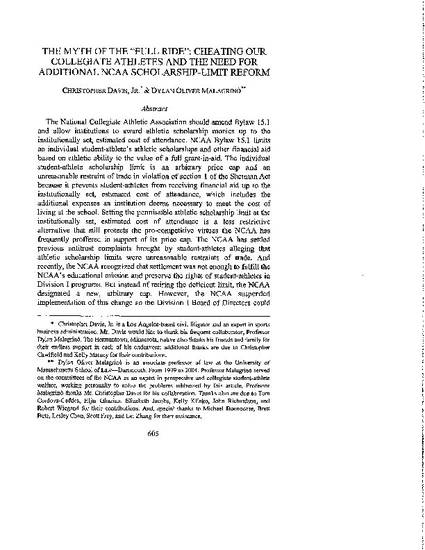
Article
The Myth of the Full Ride: Cheating Our Collegiate Athletes and the Need for Additional NCAA Scholarship-Limit Reform
Oklahoma Law Review
(2013)
Abstract
The National Collegiate Athletic Association should amend Bylaw 15.1 and allow institutions to award athletic scholarship monies up to the institutionally set, estimated cost of attendance. NCAA Bylaw 15.1 limits an individual student-athlete’s athletic scholarships and other financial aid based on athletic ability to the value of a full grant-in-aid. The individual student-athlete scholarship limit is an arbitrary price cap and an unreasonable restraint on trade in violation of Section 1 of the Sherman Act because it prevents student-athletes from receiving financial aid up to the institutionally set, estimated cost of attendance, which includes the additional expenses an institution deems necessary to meet the cost of living at the school. Setting the permissible athletic
scholarship limit at the institutionally set, estimated cost of attendance is a less restrictive alternative that still protects the pro-competitive virtues the NCAA has frequently proffered in support of this price cap. The NCAA has settled previous antitrust complaints brought by student-athletes alleging that athletic scholarship limits were unreasonable restraints on trade. And, recently, the NCAA recognized that settlement was not enough to fulfill the NCAA’s educational mission and preserve the rights of student-athletes in Division I programs. But, instead of retiring the deficient limit, the NCAA designated a new, arbitrary cap. However, the NCAA suspended implementation of this change so the Division I Board of Directors could reconsider the amendment. In reconsidering the amendment, and in light of the recent settlement in the White v. National Collegiate Athletic Association lawsuit, the NCAA should fully liberalize Bylaw 15.1 and allow institutions to award athletic scholarship monies up to the institutionally set, estimated cost of attendance. This is the only way to ensure that all future Division I student-athletes will not be financially disadvantaged even with the hard work these athletes perform for their institutions’ athletic programs; further, anything less is an unreasonable restraint on trade.
Keywords
- Bylaw 15.1,
- athletic scholarship,
- athletic scholarship limit,
- limits,
- NCAA
Disciplines
Publication Date
Summer 2013
Citation Information
Dylan O Malagrino and Christopher Davis. "The Myth of the Full Ride: Cheating Our Collegiate Athletes and the Need for Additional NCAA Scholarship-Limit Reform" Oklahoma Law Review Vol. 65 Iss. 4 (2013) p. 605 - 643 Available at: http://works.bepress.com/dylan-malagrino/6/
